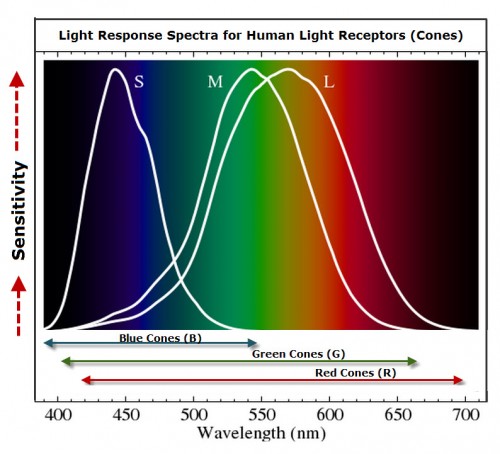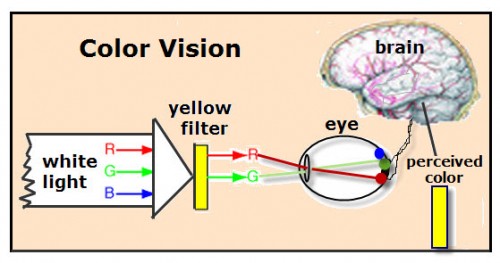Color is Not a Physical Characteristic
 The picture shows me and my granddaughter sitting in a field of bluebonnets. The sky over head is a bright blue with a floating lazy cumulus cloud. But it is what is not seen that creates a totally different scene.
The picture shows me and my granddaughter sitting in a field of bluebonnets. The sky over head is a bright blue with a floating lazy cumulus cloud. But it is what is not seen that creates a totally different scene.
A fraction of a second after the camera caught this image the smiles and laughter turned to pain and screams.
YIKES! Being in Texas, we should have known better. YEP!Beneath the carpet of flowers were intertwining fire ant tunnels with surface opening just under our bottoms. These nasty beasts not only sting but bite.
I later wondered how many passing cars were flashed as we frantically dusted fire ants off of our legs and fannies.
BACK TO COLOR!
With what is considered normal vision, I see the sky, bluebonnets and my dress in the picture as blue. A person with a type of colorblindness, called tritanopia, doesn’t see this color. Those with tritanopia are missing o ne of the three types of cones (light sensitive cells) in the eye needed for color vision.
ne of the three types of cones (light sensitive cells) in the eye needed for color vision.
Think About This!
You see the colors in the photograph on this page because light from your monitor enters your eyes and strikes the cones located on the retina (inner back surface of your eye). Each stimulated cone sends a message to your brain where the messages are combined, decoded, and the colors you see are revealed.
The three types of cones are L, M, and S, which have light sensitive pigments that respond best to light of different wavelengths.
L: Long Wavelengths, with the greatest sensitivity to light waves with a wave length of 560 nm
M: Medium Wavelengths, with the greatest sensitivity to light with a wave length of 530 nm.
S: Short Wavelengths, with the greatest sensitivity to light with a wave length of 420 nm.
In stead of calling cones, L, M, and S, you will find them referred to as Red, Green, and Blue respectively. These colors are called primary light colors.
stead of calling cones, L, M, and S, you will find them referred to as Red, Green, and Blue respectively. These colors are called primary light colors.
FACT: Primary colors are not single colors, instead they are a spectra of colors as shown in the diagram above.
A person with tritanopia doesn’t have blue (S) cones.
Diagram A shows the color spectrum for normal color vision.
Diagram B shows the color spectrum for tritanopia vision.
How You Perceive Color
 The diagram shows white light made up of the three primary light colors, red, green, and blue.
The diagram shows white light made up of the three primary light colors, red, green, and blue.
When white light passes through the yellow filter only primary light colors Red and Green pass through.
Light must enter your eye for you see anything. When the primary light colors of red and green enter your eye they are absorbed by specific cones as shown. These cones send coded messages via the optic nerve to your brain. The message sent depends on how the cones are stimulated. In the example the brain receives, combines and decodes the messages. The addition of the messages results in the perceived color of yellow.
This is called trichromatic color vision, which is accomplished by using combinations of the responses of the three types of cone cells.
Use Discount Code– AFF20 —-to save 20% on Purchases.
Other Biology Books
Plants